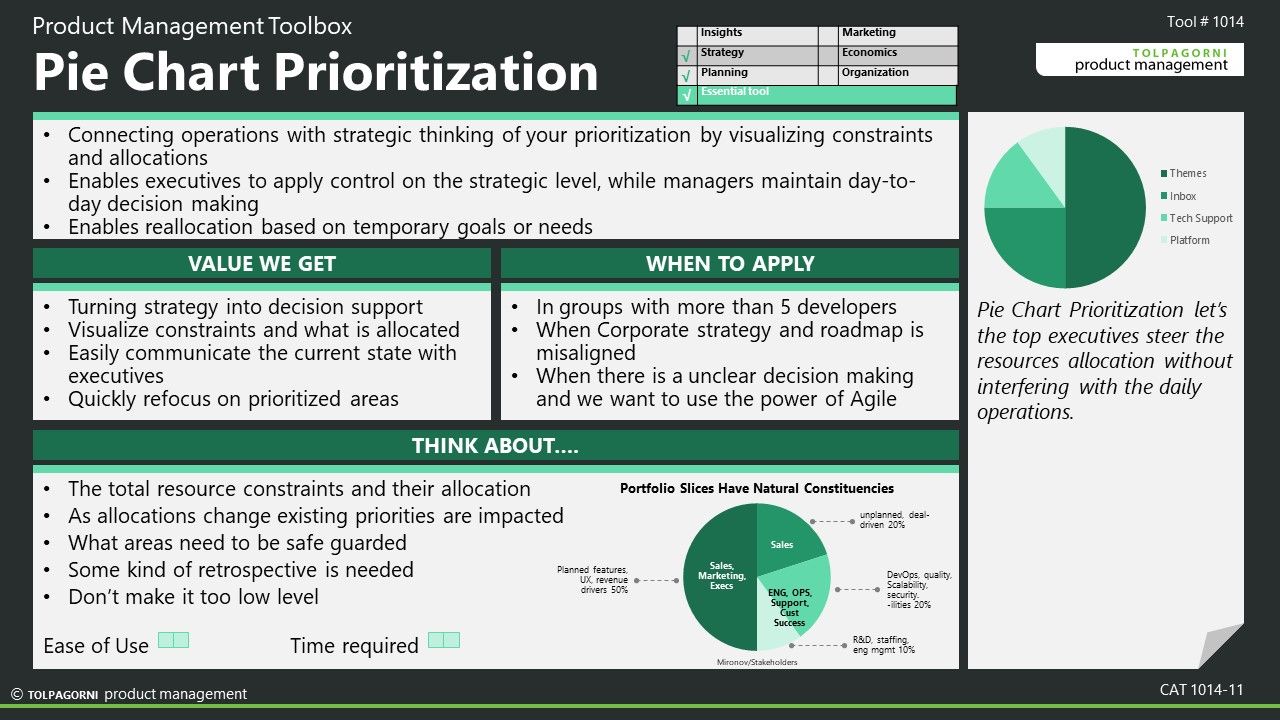Tool #14

Grok the Logic - Reach the Magic
The Pie chart is Magic. It is simple, everyone understands, and it looks good on a PowerPoint!
You are already using a pie chart, you have done that since fifth grade. But have you discovered the Logic and Magic of the Pie Chart? Once you start to understand the pure Logic of Pie Chart, it unveils Product Management Secrets. The Pie chart is a process; it is a decision-making tool; it is a decision facilitator; it is a resource planner, it is the roadmap... Correctly used, it can be the only tool you need to use!
Let's take a look at the components of a Pie chart. I want to cover 6 Pie chart concepts we have worked with and successfully implemented in numerous companies.
- The size of the Pie
- The types of slices you have
- The size of the slices
- The content in the slice
- Ownership of the Pie and the slices
- The Pie Process
- PIE SIZE
The size is the resources available for your product. Mostly we use the PIEs for development, but it can also include other resources such as marketing, salespeople, Somewhere there is a decision on the resources you get. The Pie chart is also an excellent tool to show what you can achieve with the given resources. It will show management what we CANNOT do with the existing team.
SLICE TYPES
The types of slices you have are your vital areas. The choice of slices is often a part of your product strategy. It can be traditional slices like Feature, Bespoke Development, Quality, Operations, Architecture, etc. But in some cases, it makes more sense to have slices on modules in your product like Platform, API, XX Application, YY Application, ZZ Application, etc. In one case, we implemented slices based on markets like (the UK, Nordics, China, Europe...). The choice of slices will decide how the teams view the product you are managing.
SLICE SIZE
The decision on sizes of slices is the link between strategy and operations. How much time shall you spend on fixing Quality issues? How much of our resources shall we spend in getting ready for the Chinese launch? The decision of the slice size is exceptionally strategic and operational at the same time.
SLICE CONTENT
The content of a slice is an exciting topic. How do we decide over that? in some cases, we have worked with themes in the slices. The quality might have a theme like " the CSR-Ceasar" perspective. Then we automatically prioritize quality issues that affect "CSR- Ceasar." Each slice can have has its backlog. The backlog grooming is done separately for the different slices. You can also steer the content of the slice by defining the prioritization logic of how we shall rank the various proposals.
OWNERSHIP
Somebody has control over the pie size. Someone else might have a saying on the types of slices. The ownership of a slice can also be different than the ownership of a Pie. Someone decides the complete product budget; another decides on how to spend the quality slice. The pie chart is a beautiful tool to define the ownership. And the cool thing about it is that it is connected with the strategy and the operations. So you get ownership of the strategy execution.
PIE PROCESS
Obviously, there is no timeline in a pie chart. To make it work in reality, you have to create a separate pulse/process to make the Pie Chart work. The process shall answer questions like: When do we make decisions on the types of slices, And by whom? How often do we challenge the content of the slice? And who is doing that? When do we decide upon the size of the Pie? And who? Etc. With the Pie Chart as a starting process, you can define a Product management process.
Grok the Logic - reach the Magic
The pie chart logic contains a depth that you can leverage on. It allows a complex decision-making process to become easily communicated. The real Magic appears when you and the stakeholders grok the Logic of Pie Charts. In a given size of the Pie; One slice cannot grow without reducing another one! When you understood the Logic of the pie chart, you get the Magic!
Attached are some documents referring to prioritization in general and with examples of Pie Chart thinking.
- Overview Prioritization
- A paper from Rich Mironov on Prioritization thinnking
- How to think when preparing for a roadmap - with a Pie chart example
- @Daniel Zacarias paper on prioritization
Empty space, drag to resize
Empty space, drag to resize
Oops, looks like you're not logged in!
Log in in order to access the tool!
Copyright © 2023 ProductBeats AB

Get The Program Brochure
Submit the form below to have The Program Brochure delivered to your inbox
The title of the notification
The descriptive text of the notification

